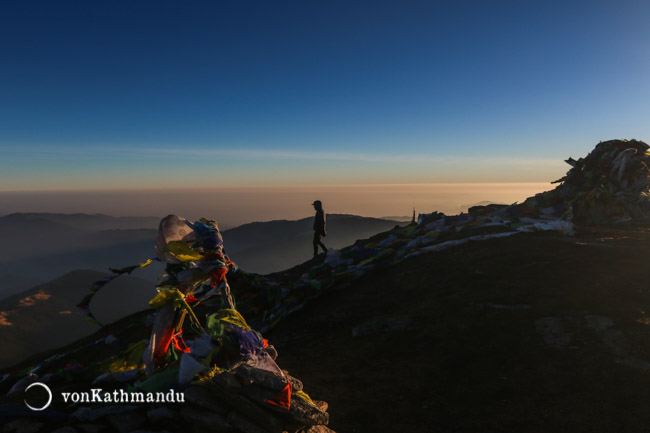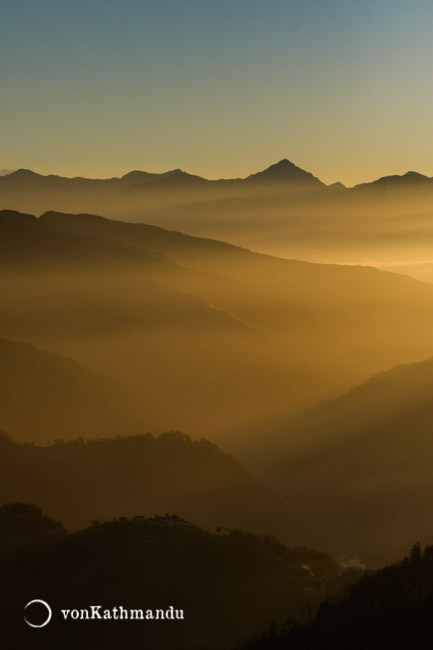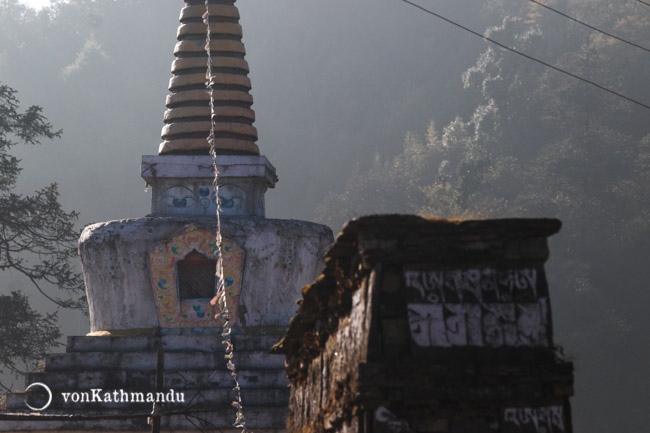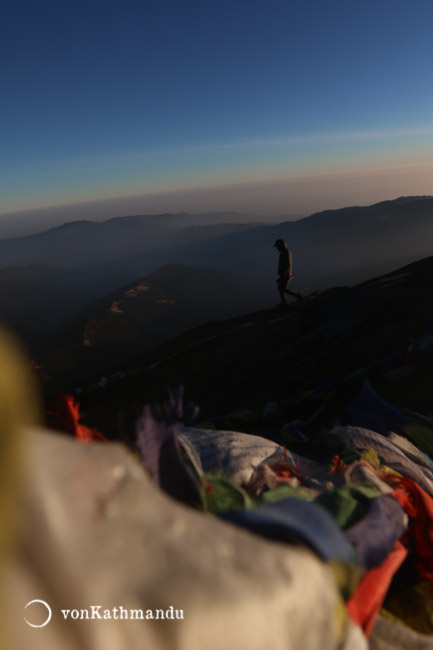|
Mountain Trek / Everest Region / Nepal Pikey Peak Express TrekNext tentative Date: Available as a Private Trek on a date of your preference.
The best-kept secret in lower Solukhumbu makes for a grand alpine landscape and culture trek, with Everest and other mountains dominating the horizon. |
Overview
The best-kept secret in lower Solukhumbu makes for a grand alpine landscape and culture trek, with Everest and other mountains dominating the horizon.
Highlights
| View of high Khumbu mountains and and deep Solu valleys seen from Dhap | |
| Alpine forests and breezy ridge walk | |
| The tiny settlement of Jhapre and layers of hills and mountains seen from here | |
| Serene and gradual walk up to Pikey Peak Base Camp, above the treeline on crazy landscapes | |
| Changing landscapes - thick jungles, alpine, rocky | |
| 360-degree view of the mountains and stretch as wide as the eyes can see | |
| Lovely jungle descent down to Junbesi. | |
| Well serviced lodge with warm hot shower in Junbesi. |
Is this trip for me?
Anybody with basic hiking experience and an active lifestyle can opt for the Pikey Peak Express Trek. For the most part, the gradient of the trail is fairly levelled with some gradual uphill except one day, where you will experience a mix of uphills and steep downhill stretching over hours. The highest elevation you will reach is Pikey Peak (4,065M / 13,337Ft), making the risk of altitude sickness very low. We maintain a very comfortable hiking pace throughout the trek.
The accommodation on the first few days is at basic mountain lodges. For a safe and fun experience, there will be experienced trekking guide and porters (carrying your luggage) accompanying you.
Best time to go
The weather in the Himalayas varies greatly based on altitude and season. The higher you ascend, the colder and more unpredictable the conditions become.
JanFebMarAprMayJunJulAugSepOctNovDec
JanFebMarAprMayJun
JulAugSepOctNovDec
| Group Size | Price per person* |
| 3 people | USD 720 |
| 4- 7 people | USD 600 |
| 8 and above | USD 550 |
|
|
|
|
|
Valid until Dec 31st, 2024

An unbroken chain of Khumbu mountains stretch across the horizon

Last rays of sun on Everest seen from Pikey Peak

Above the misty valley

An early morning jaunt to Pikey Peak is rewarding and peaceful

Photogenic houses are as charming as the views seen from here

A smiley lady in Pikey Peak Base Camp ready to serve you dalbhat and stories

Walking down to the picturesque Sherpa town of Junbesi

The entire trek boasts houses with traditional Sherpa architecture

Cheeky kids in Jhapre

At Pikey Peak top, surrounded by prayer flags

Catch great views of rolling hills and mountains as you gradually gain elevation

Walking up the vast open landsacpes to reach the famed viewpoint

Clear skies far away from light pollution and off the grid

Vibrant yellow morning in the valley and hills of Jhapre

Walking downhill through rhododenron forests to Junbesi

A girl in Jhapre

Buddhist Chorten and Mani Wall, with prayers incribed

Ridge to Pikey Peak gets the evening lights just before sunset

Mount Everest peeks between smaller neighboring mountains in the Khumbu region, seen here from Pattale

Terraced fields and woods are riddled by houses with dictinctly blue roofs of Sherpa houses

Dwarfed by mountains that rise high above the mist

Layers of hills merge into snowcapped Himalayas

Traditional house en route to Junbesi

Numbur mountain appears huge in the horizon of Khumbu mountains

Traverse through wide open pastures

Get views of mountain ranges Ananpurna to the west and Kanchenjunga to the south

Prayer flags flutter in the chilly dawn atop Pikey Peak

Basking lazily under the winter sun
Itinerary
|
Day 1 |
Kathmandu - Singane |
|
|
Day 2 |
Jhapre - Pikey Peak Base Camp |
|
|
Day 3 |
Pikey Peak Base Camp - Pikey Peak - Junbesi |
|
|
Day 4 |
Junbesi [Exploration to Thupten Choling Monastery] |
|
|
Day 5 |
Junbesi - Kathmandu |
|
|
Day 1 |
Kathmandu - Singane |
|
|
Drive from Kathmandu to Singane 8 to 9 hrs Set off to Pattale on an eight-hour-long scenic drive along the winding hilly roads east of Kathmandu. You will witness tiny villages nestled in the hills as well as the modernizing highway cities on this journey that constantly follows a river. We make multiple stops on the way for lunch, tea, and restroom. Our stop for the night is Pattle, a tiny village that offers a range of mountains on the horizon. |
|
|
Trek from Singane to Jhapre 2 to 2.5 hrs We start walking after getting dropped off at Dhap, and the sights of the mountains stay with us throughout. Jhapre is another lovely place with views of rolling valleys and mountains that start appearing closer. |
Meals Included: Breakfast
Accommodation: Mountain Lodge
|
Day 2 |
Jhapre - Pikey Peak Base Camp |
|
|
Trek from Jhapre to Pikey Peak Base Camp 5 to 6 hrs The walk takes us above the treeline today, and in a wide prairie-like landscape, the panorama starts getting more dramatic. As we gain more elevation, we get 360-degree view of the mountains on one side and layers of hills on the other. It can get quite windy so have a windcheater handy. We check into a hotel at Pikey Peak Base Camp and have some hot food. Although we'll be going to Pikey Peak the following morning for sunrise, you may choose to either take rest for the day today or make it up to Pikey Peak in late afternoon to watch the sunset over the mountains. |
Meals Included: Breakfast
Accommodation: Mountain Lodge
|
Day 3 |
Pikey Peak Base Camp - Pikey Peak - Junbesi |
|
|
Trek from Pikey Peak Base Camp to Junbesi, via Pikey Peak 7 to 8 hrs We set off to Pikey Peak early morning before dawn to catch the changing colors and sunrise over Khumbu mountains. Besides Everest, you can see other giant mountain ranges like Kanchenjunga, Makalu, Manaslu and Annapurna. After photo ops and catching final glimpses from Pikey Peak, we walk down to Jasmane Bhanjyang where we have a hearty breakfast, then on to the gorgeous monastery town of Junbesi through lush jungle. |
Meals Included: Breakfast
Accommodation: Mountain Lodge
|
Day 4 |
Junbesi [Exploration to Thupten Choling Monastery] |
|
|
Explore Junbesi and hike to Thupten Choling 3 to 3.5 hrs Junbesi has a lot to offer. We explore this picturesque town of Junbesi and visit the biggest and oldest monastery of Solu- Thupten Choling. We spend some time in peace and make our way back to Junbesi for lunch. |
Meals Included: Breakfast
Accommodation: Mountain Lodge
|
Day 5 |
Junbesi - Kathmandu |
|
|
Drive from Junbesi to Kathmandu 9 to 10 hrs We have an early breakfast in Junbesi before driving back to Kathmandu. |
Meals Included: Breakfast
Mountain Lodge |
X Close Popup
X Close Popup
Mountain lodges are the basic accommodation set up by locals to cater to trekkers in the trails. The common features across all lodges are standard rooms, a spacious and heated dining hall, and a restaurant with a menu. The rooms in mountain lodges generally have two or three twin beds with a mattress and blanket. If you are used to sleeping warm, we highly recommend bringing your own sleeping bag and liner. Other amenities could be a table, hanger, and dustbin but do not expect to have charging ports and attached toilets in the rooms. Moreover, it is mandatory to have meals in the facility you’re staying at.
Room Amenities
| • | Shared Toilet |
Property Amenities
| • | Restaurant and Bar | • | Outdoor Seating | • | Mountain Views |
Mountain Lodge |
X Close Popup
X Close Popup
Mountain lodges are the basic accommodation set up by locals to cater to trekkers in the trails. The common features across all lodges are standard rooms, a spacious and heated dining hall, and a restaurant with a menu. The rooms in mountain lodges generally have two or three twin beds with a mattress and blanket. If you are used to sleeping warm, we highly recommend bringing your own sleeping bag and liner. Other amenities could be a table, hanger, and dustbin but do not expect to have charging ports and attached toilets in the rooms. Moreover, it is mandatory to have meals in the facility you’re staying at.
Room Amenities
| • | Shared Toilet |
Property Amenities
| • | Restaurant and Bar | • | Outdoor Seating | • | Mountain Views |
Mountain Lodge |
X Close Popup
X Close Popup
Mountain lodges are the basic accommodation set up by locals to cater to trekkers in the trails. The common features across all lodges are standard rooms, a spacious and heated dining hall, and a restaurant with a menu. The rooms in mountain lodges generally have two or three twin beds with a mattress and blanket. If you are used to sleeping warm, we highly recommend bringing your own sleeping bag and liner. Other amenities could be a table, hanger, and dustbin but do not expect to have charging ports and attached toilets in the rooms. Moreover, it is mandatory to have meals in the facility you’re staying at.
Room Amenities
| • | Shared Toilet |
Property Amenities
| • | Restaurant and Bar | • | Outdoor Seating | • | Mountain Views |
Mountain Lodge |
X Close Popup
X Close Popup
Mountain lodges are the basic accommodation set up by locals to cater to trekkers in the trails. The common features across all lodges are standard rooms, a spacious and heated dining hall, and a restaurant with a menu. The rooms in mountain lodges generally have two or three twin beds with a mattress and blanket. If you are used to sleeping warm, we highly recommend bringing your own sleeping bag and liner. Other amenities could be a table, hanger, and dustbin but do not expect to have charging ports and attached toilets in the rooms. Moreover, it is mandatory to have meals in the facility you’re staying at.
Room Amenities
| • | Shared Toilet |
Property Amenities
| • | Restaurant and Bar | • | Outdoor Seating | • | Mountain Views |
Customize this trip
Take a heli back.
For those short on time or looking to add an exhilarating experience of flying over the majestic Himalayas, you have the option to charter a private helicopter on the way down. Inquire for prices and options!
Kathmandu Hotel and Transfers
-
If you’d like us to organize airport transfers and arrange your stay in Kathmandu or any other cities, let us know. We’re happy to give you options based on your preference, and book them for you.
Here’s one of our popular 2 days add-on: USD 185 per person:
- Airport pick up and drop off, facilitated by an English-speaking representative
- 2 nights in a four-star hotel in Kathmandu (Hotel Shankar or similar) on bed & breakfast plan and twin-sharing basis


